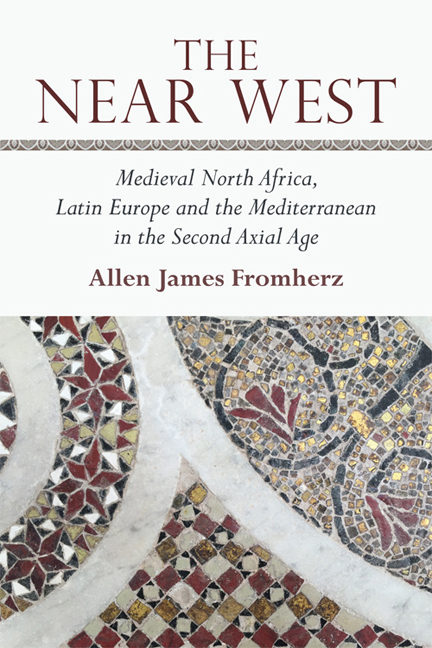Book contents
- Frontmatter
- Contents
- Map: The Near West – Medieval North Africa and Europe
- Personal Note and Acknowledgments
- Introduction: North Africa and the Mediterranean Paradox
- 1 Bèjaïa: Introducing North Africa, Latin Europe and the Mediterranean
- 2 Rome: North Africa and the Papacy
- 3 Tunis: Axis of the Middle Sea
- 4 Marrakech: The Founding of a City
- 5 The Almohads: Empire of the Western Mediterranean
- 6 Between City and Countryside: Ibn Khaldun and the Fourteenth Century
- 7 Conclusions: A Second Axial Age
- Notes
- Bibliography
- Index
2 - Rome: North Africa and the Papacy
Published online by Cambridge University Press: 23 September 2017
- Frontmatter
- Contents
- Map: The Near West – Medieval North Africa and Europe
- Personal Note and Acknowledgments
- Introduction: North Africa and the Mediterranean Paradox
- 1 Bèjaïa: Introducing North Africa, Latin Europe and the Mediterranean
- 2 Rome: North Africa and the Papacy
- 3 Tunis: Axis of the Middle Sea
- 4 Marrakech: The Founding of a City
- 5 The Almohads: Empire of the Western Mediterranean
- 6 Between City and Countryside: Ibn Khaldun and the Fourteenth Century
- 7 Conclusions: A Second Axial Age
- Notes
- Bibliography
- Index
Summary
For years the frightful basilisk, a dragon-like creature that could kill with his foul breath or stun with a mere look from his devilish eyes, haunted the city of Rome. The serpent roamed around the city, cruelly taking victim after victim. One day, Pope Leo IV, like a courageous lion, “halted fearlessly over the cleft from which the breath of that plague-bearing serpent emerged. Raising eyes and hands to heaven, with abundant tears he besought Christ who is God above all to put to flight by his power the dire kind of serpent from that place.” The serpent died. Although historians say the monster was probably just some particularly bad methane gas expelling from the piles of rubbish around Rome, the death of this frightful beast, the embodiment of so many calamities, added to the reputation of the Bishop of Rome: the Pope. The papacy in the first half of the ninth century desperately needed these miracles. Popes were expected to prove their holiness through prayerful and successful appeals to God. Many popes before him were lackluster at this skill and the fate of Rome seemed dire. Leo IV marked Rome's turning point in the economy of miracles. Indeed, every trial under Leo IV came with its concomitant miracle, with proof of God's renewed favor for the desperate city of Rome. One of the greatest “divine interventions” would defeat another fabled monster from the outside, “Saracens.” The so-called “Saracens” were actually Berber North African and Sicilian raiders who, according to papal accounts, sacked not only Rome but the very tombs of St. Peter and St. Paul in 846. They threatened Rome in 849 as well.
The city the North Africans and Sicilians were attacking had long been blessed and cursed by its fame. As with Jerusalem, Rome was, and is, more important as a symbol than as a place. Inevitably, there was always tension between what Rome was as a city for itself and what it was supposed to be for the outside world. There were two great Romes: one Rome of daily experience and political power and one Rome of symbol and ideals. There was the Rome of economic decline, malaria, earthquake and flood, the Rome of constant internecine struggle between families, the papacy and outside kings.
- Type
- Chapter
- Information
- The Near WestMedieval North Africa, Latin Europe and the Mediterranean in the Second Axial Age, pp. 58 - 85Publisher: Edinburgh University PressPrint publication year: 2016



